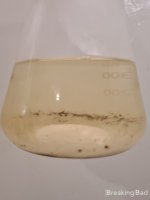- Joined
- Mar 15, 2022
- Messages
- 650
- Solutions
- 1
- Reaction score
- 632
- Points
- 93
- Deals
- 8
I have an alkali mixture of water and meth freebase.
I add solvent in that case Hexane and in the bottom layer appears something that hexane dont dissolve and later the water layer ok.
When I isolate this "impurity" I mix it with DCM and its dissolved.
So here is the dilemma this situation means:
1- Hexane is not enough good solvent for that kind of freebase.
2- DCM dissolves some organic impurities.
What you would do discard it or solve it in DCM evaporate solvent and use it?
Thanks.
I add solvent in that case Hexane and in the bottom layer appears something that hexane dont dissolve and later the water layer ok.
When I isolate this "impurity" I mix it with DCM and its dissolved.
So here is the dilemma this situation means:
1- Hexane is not enough good solvent for that kind of freebase.
2- DCM dissolves some organic impurities.
What you would do discard it or solve it in DCM evaporate solvent and use it?
Thanks.


